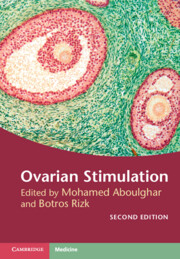Book contents
- Ovarian Stimulation
- Ovarian Stimulation
- Copyright page
- Dedication
- Contents
- Contributors
- About the Editors
- Foreword
- Preface to the first edition
- Preface to the second edition
- Section 1 Mild Forms of Ovarian Stimulation
- Section 2 Ovarian Hyperstimulation for IVF
- Section 3 Difficulties and Complications of Ovarian Stimulation and Implantation
- Chapter 12 Ovarian Stimulation in Difficult IVF Cases
- Chapter 13 Polycystic Ovary Syndrome: Ovulation Induction Strategies
- Chapter 14 Polycystic Ovary Syndrome: Controlled Ovarian Stimulation
- Chapter 15 Prevention of Ovarian Hyperstimulation Syndrome
- Chapter 16 Treatment of Ovarian Hyperstimulation Syndrome
- Chapter 17 How to Individualize Ovarian Stimulation Protocols to Avoid Difficulties and Complications
- Chapter 18 Endometrial Receptivity
- Chapter 19 Folliculogenesis and Implantation Failure
- Section 4 Non-conventional Forms Used during Ovarian Stimulation
- Section 5 Alternatives to Ovarian Hyperstimulation and Delayed Transfer
- Section 6 Procedures before, during, and after Ovarian Stimulation
- Index
- References
Chapter 15 - Prevention of Ovarian Hyperstimulation Syndrome
from Section 3 - Difficulties and Complications of Ovarian Stimulation and Implantation
Published online by Cambridge University Press: 14 April 2022
- Ovarian Stimulation
- Ovarian Stimulation
- Copyright page
- Dedication
- Contents
- Contributors
- About the Editors
- Foreword
- Preface to the first edition
- Preface to the second edition
- Section 1 Mild Forms of Ovarian Stimulation
- Section 2 Ovarian Hyperstimulation for IVF
- Section 3 Difficulties and Complications of Ovarian Stimulation and Implantation
- Chapter 12 Ovarian Stimulation in Difficult IVF Cases
- Chapter 13 Polycystic Ovary Syndrome: Ovulation Induction Strategies
- Chapter 14 Polycystic Ovary Syndrome: Controlled Ovarian Stimulation
- Chapter 15 Prevention of Ovarian Hyperstimulation Syndrome
- Chapter 16 Treatment of Ovarian Hyperstimulation Syndrome
- Chapter 17 How to Individualize Ovarian Stimulation Protocols to Avoid Difficulties and Complications
- Chapter 18 Endometrial Receptivity
- Chapter 19 Folliculogenesis and Implantation Failure
- Section 4 Non-conventional Forms Used during Ovarian Stimulation
- Section 5 Alternatives to Ovarian Hyperstimulation and Delayed Transfer
- Section 6 Procedures before, during, and after Ovarian Stimulation
- Index
- References
Summary
Ovarian hyperstimulation syndrome (OHSS) is the most serious iatrogenic complication of excessive response to ovulation induction or ovarian stimulation during in vitro fertilization/intracytoplasmic sperm injection (IVF/ICSI) treatment cycles [1–5] The incidence of OHSS has been estimated at 20–33% for mild cases, 3–6% for moderate cases, and 0.1% and 2% for severe cases [6–8]. OHSS is characterized by bilateral, multiple follicular and theca-lutein ovarian cysts (Figure 15.1) and an acute shift in body fluid distribution resulting in ascites (Figure 15.2) and pleural effusion. Rizk and Smitz [9], in an analytical study of the factors that influence the incidence of OHSS, found a wide variation among different centers.
- Type
- Chapter
- Information
- Ovarian Stimulation , pp. 141 - 157Publisher: Cambridge University PressPrint publication year: 2022



